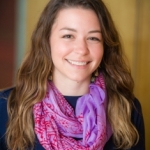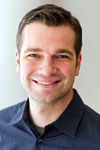Membership

Anna Stokes

Tommy Butler
Designing Better Leaders through Cross-Sector Collaboration
Posted by Apr 15, 2015

Anna Stokes

Tommy Butler
There’s absolutely nothing revolutionary about leadership development. All across the country (and the world) opportunities to enhance and develop one’s professional skills seem to be popping up in every corner. But when the Arts + Business Council of Greater Philadelphia (ABC) won a challenge grant from the John S. and James L. Knight Foundation, we chose to take leadership development in a direction that encouraged arts administrators to not just think about themselves as nonprofit leaders but as Leaders, with a capital “L”.
According to Americans for the Art’s latest Creative Industries Report, the City of Philadelphia has the fifth highest percentage of arts-related jobs in a comparison of the 100 largest cities in nation (4.94%, including both for-profit and nonprofit creative industries). At number five, our creative community is both ahead of the pack and has room to grow, and what better way to grow this sector than to invest in its leaders.
Read More
Ms. Laura Bruney
Using the Arts to Revitalize Downtown Miami
Posted by Apr 09, 2015

Ms. Laura Bruney
This piece by Laura Bruney of the Arts & Business Council of Miami was originally published on their blog, www.artsbizmiami.org/ArtsBizBlog.
Alyce Robertson is Executive Director of Miami’s Downtown Development Authority. The Great Recession wreaked havoc on downtown Miami, with empty condos and a surplus of office space that even the most bullish economists thought would take a decade to absorb. But the turn-around has been quicker and better than imagined. A 24-7 community has emerged as thousands of new residents and business professionals flood the district seeking a more urban lifestyle. Today, Miami has reversed course and emerged as a true metropolis and international destination for commerce, tourism, and arts & culture. Alyce shares her views with us on the value of the arts to downtown Miami.
Read More
Ms. Caitlin Holland

So What do You Do?
Posted by Mar 30, 2015

Ms. Caitlin Holland

This blog post is an extended interview from the Spring issue of Americans for the Arts member magazine Arts Link. Americans for the Arts’ Emerging Leader program celebrates its 15th anniversary this year in 2015. Leslie Ito was one of the founding members and she is interviewed by another founding member, Graham Dunstan, Americans for the Arts vice president of marketing and communications.
Featured Americans for the Arts member: Leslie Ito
Position: president and CEO, Japanese American Cultural and Community Center
Please tell our readers about your organization.
The Japanese American Cultural and Community Center (JACCC) was founded in 1972 and is a two-acre campus in the Little Tokyo district of downtown Los Angeles. We have a five-story building that houses different nonprofit organizations, but we also manage a professional gallery space, a tea room, a ukulele café and store, a large plaza designed by renowned artist Isamu Noguchi, and the 880-seat Aratani Theatre.
Read More
Mr. Abel Lopez

Mr. Edgar L. Smith, Jr.
Giving Time and Treasure to the Arts
Posted by Oct 20, 2014

Mr. Abel Lopez

Mr. Edgar L. Smith, Jr.
Welcome to Americans for the Arts’ latest blog salon, hosted by a hybrid of development and private sector partners. “Giving Time and Treasure to the Arts” can be interpreted in many ways depending on who’s doing the talking. It can mean raising support from corporate partners, building relationships with passionate individual philanthropists, engaging employee volunteers, or harnessing the power of creativity to increase productivity and happiness in the workplace. We welcome you to join us throughout the week to learn what “giving time and treasure to the arts” means to our members around the country, as well as some of our sector’s greatest supporters.
The role played by volunteers and philanthropists from the largest city to the smallest town is key to fostering a thriving arts sector in America. Both elements that this blog salon focuses on are important: the time and talent of volunteers provide capabilities and experiences that many arts organizations do not have the resources to procure; and the donation of funds, services, and other “treasures” allows the field not only to produce great art, but also to be the economic drivers and job creators that we know the arts to be. The decision to give to the arts is essential, and we make that choice and encourage others to make the same one because the arts themselves are essential.
Read More
Nina Simon
Audience Development, Venn Diagram Edition
Posted by Oct 04, 2012

Nina Simon
 Nina Simon
Nina Simon
A lot of conversations I have about audience development with organizational leaders go something like this:
"We want to find ways to make our institution more participatory and lively."
"Great!"
"We want to cultivate a more diverse audience, especially younger people, and we want to do it authentically."
"Fabulous!"
"But our traditional audience doesn't come for that, and we have to find a way to do this without making them uncomfortable."
"Hm."
Audience development is not an exercise in concentric circles. You can't just start with who you already have in the middle and build infinitely outward. In most cases, growth means shifting, and shifting means that some people leave as others come.
This is incredibly scary. It requires trading a certain history for an uncertain future—a nerve-wracking prospect no matter the situation. It's particularly scary if your institution relies primarily on private donors, members, and gate sales to cover operating costs. When funding is tied to a specific subset of your audience, you get protective of them, even if they are not the people most likely to ensure viability and sustainability in the future.
When I took on the director role at the Santa Cruz Museum of Art & History, we were in a dangerous situation. We had a small cohort of members and donors who loved and supported us. Outside of that, our bench was very thin—no brand recognition, no up-and-coming audience, no big funders with an eye on the future of the organization.
Now, a year later, we’ve more than doubled our attendance, increased membership by 30%, attracted national foundation funders, and gotten great ink locally. Our audience has gotten younger and they come more frequently.
Read More
Roger Vacovsky
Is Your Organization Prepared? Get ArtsReady with Americans for the Arts Membership
Posted by Sep 18, 2012

Roger Vacovsky
 Did you know that September is National Preparedness Month? It seems like a strange time of the year to promote emergency preparedness, especially for Atlantic Coast dwellers such as myself. This is one of the most active periods of the year for hurricanes, and I would like to think that any individual or organization would already have a plan in place should they encounter such a natural disaster.
Did you know that September is National Preparedness Month? It seems like a strange time of the year to promote emergency preparedness, especially for Atlantic Coast dwellers such as myself. This is one of the most active periods of the year for hurricanes, and I would like to think that any individual or organization would already have a plan in place should they encounter such a natural disaster.
Well, I don’t. I haven’t figured out if the structure in which I live in is sturdy enough to withstand a heavy storm, I haven’t mapped out an evacuation route, I haven’t found a location in my neighborhood where I can seek shelter (I’m assuming it’s a local school, but I don’t even know where that is nearby where I live). I don’t have any of my files stored up in a cloud where I could retrieve them should I lose my hard drive. I’m not prepared.
You think I would have learned better. In September 2005, I was living in Houston when Hurricane Rita hit, and that was right after Katrina devastated New Orleans. Luckily, back then I did have a plan. The fourth largest city in the United States was trying to evacuate and jammed all major thoroughfares to the point where folks ran out of gas trying to get out of the area. My roommate and I mapped out a network of side streets that took us all the way out of the city to his father’s place north of the beltway and out of harm’s way.
So, having escaped that hardship unscathed, you would think I always have a preparedness plan in place, no matter where I live. The truth is, always being prepared for a seemingly rare disaster is a hard thing to keep up with. I’m willing to bet that many of us don’t afford the time to back our work up on a second hard drive, or store extra cans of food and water in case of a power outage, or know where our evacuation location is.
I think it is ingenious that South Arts developed an emergency preparedness tool called ArtsReady for arts organizations. The ArtsReady toolkit tells you what you need in place to have a solid emergency plan. They have the ability to store your files in their cloud for you, they give you all of the information of emergency contacts for you and have even developed a network of participating organizations that you can go to for help should you encounter an unfortunate situation.
Read More
Roger Vacovsky
Listening to Members to Develop Loyalty
Posted by Jun 09, 2012

Roger Vacovsky
Yesterday at the Americans for the Arts Annual Convention in San Antonio, attendees engaged in a session that asked them to reconsider the classic membership model and theory behind membership and subscription programs.
As we are circling around this concept of “the new normal,” we must begin to look at the fact that the changing culture of our work force has different wants and needs. With regards to membership, this new crop of individuals want the tangible, the direct benefit, and the question that will be asked after (or instead of) “Why should I join?” is, “What am I going to get for my money?”
We also know that “we’re doing it this way because this is how we’ve always done it” is OUT. If you’re membership is declining, it’s time you try something different.
Membership, in many cases, is utilized for financial reasons more so than for purposes of engagement. As membership is a revenue strain (and, as we membership folk proclaim, our job depends on that revenue), it is important to consider the ‘why’ when promoting membership.
Deborah Obalil, who moderated the session asked participants to “be honest with yourself about why you are doing it. Memberships can inspire, or fail to inspire loyalty” without a defined goal in sight.
Obalil then asked attendees to think of their own membership program with regards to what they do to inspire loyalty. The loyalty of a member to an organization consists of the following:
- Belief in the mission
- Tangible benefits: “what are they getting out of it?”
- Recognition/validation “wearing membership as a badge of honor”
Read More

Roger Vacovsky
Connecting the Past with the Future
Posted by Jan 18, 2012

Roger Vacovsky
Last week, I renewed my membership for my alma mater’s alumni association. I understand now, more than ever, that my participation in the program contributes to not only the future success of my university, but also to my own past experiences.
Since my graduation, I have enjoyed watching the University of Houston (UH) flourish, albeit from afar, receiving periodic email updates regarding the upgrades to the campus. This includes the Cynthia Woods Mitchell Center for the Arts, a tremendous effort by the university to combine five arts-based departments into one collaborative arts force. Although I am just one alumnus contributing to my university’s growth, I feel as though I played a part in making these improvements possible.
I was even eager to experience the progress of the Houston Cougar football team in 2011—which I had absolutely no part in during my time in school—as it set records for a fierce offense and toppled another, much more storied (and recently infamous) football program in a bowl appearance this year in Dallas.
There are many good reasons why we become members of our graduating university’s alumni association. As I had mentioned before, we begin giving back to the institution that helped us prepare for a successful career. We want to enhance the experience of the future generation of students so that they can go on to achieve greatness.
Believe it or not, the continued success of your alma mater retroactively increases the worth of your degree. By becoming a member of your alumni association, your membership dues help your university realize the success it consistently fights to achieve.
Read More
Americans for the Arts

Dr. Silagh White

Dr. Silagh White

Americans for the Arts

Nora Koerner

Americans for the Arts

Americans for the Arts

Americans for the Arts

Nora Koerner
New Year, New Career Goals
Posted by Jan 24, 2008

Nora Koerner
New Year, New Goals
By now, you've probably made a few New Year's resolutions: lose weight, quit smoking, or be more organized. But have you set career goals for 2008? Are you where you expected to be at this point in your career?
With the new year comes new insight and a fresh opportunity to reflect on where you've been and where you want to go. Peter Weddle, a leading expert in human resources, offers an idea called Career Fitness, described below.
Read More
Americans for the Arts
Do you know someone who is making a difference?
Posted by Jan 10, 2008

Americans for the Arts
Do you want to acknowledge an exceptional arts education leader?
Do colleagues call you an arts advocacy superhero?
Did a business executive in your community go above and beyond for the arts this year?
It's time to recognize their hard work.
Americans for the Arts presents the Annual Awards to honor the achievements of leaders committed to enriching their communities through the arts each year. For every path an arts professional's career might take, there is an award that is right for them:
Alene Valkanas State Arts Advocacy Award
Arts Education Award
Emerging Leader Award
Michael Newton Award for United Arts Funds Leadership
Public Art Network Award
Selina Roberts Ottum Award for Arts Leadership

Americans for the Arts
Peer Leadership - Council Election Results
Posted by Jan 02, 2008

Americans for the Arts
Americans for the Arts is pleased to announce our Council election results. Below are your peers from across the country who will be serving on the following Councils starting next year. Thank you to everyone who submitted nominations and who voted online. We are looking forward to working with these leaders throughout their terms.
Arts Education Council
Emerging Leader Council
Public Art Network (PAN) Council
United Arts Fund (UAF) Council

Nora Koerner

Americans for the Arts
Vote NOW! Americans for the Arts Council Elections Close Friday
Posted by Nov 29, 2007

Americans for the Arts

Americans for the Arts







